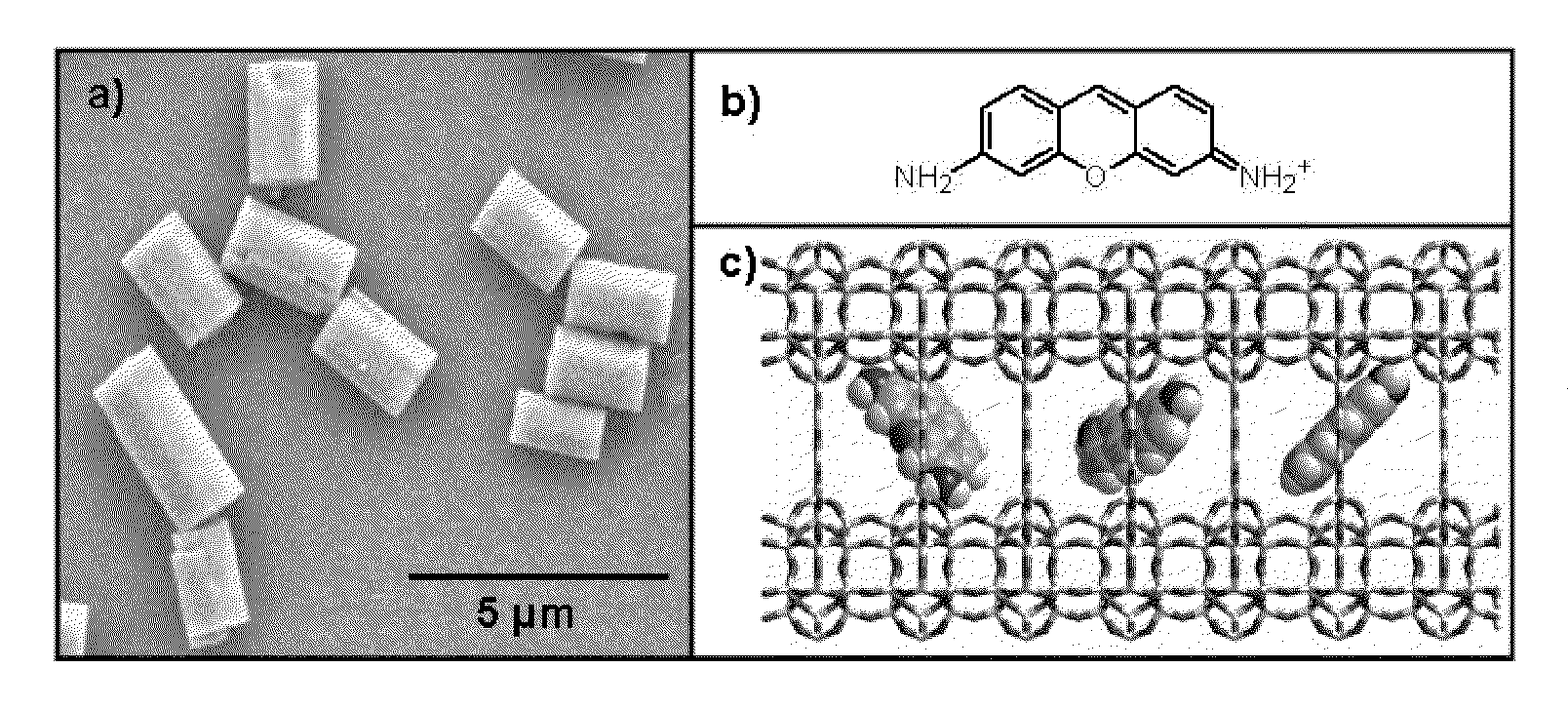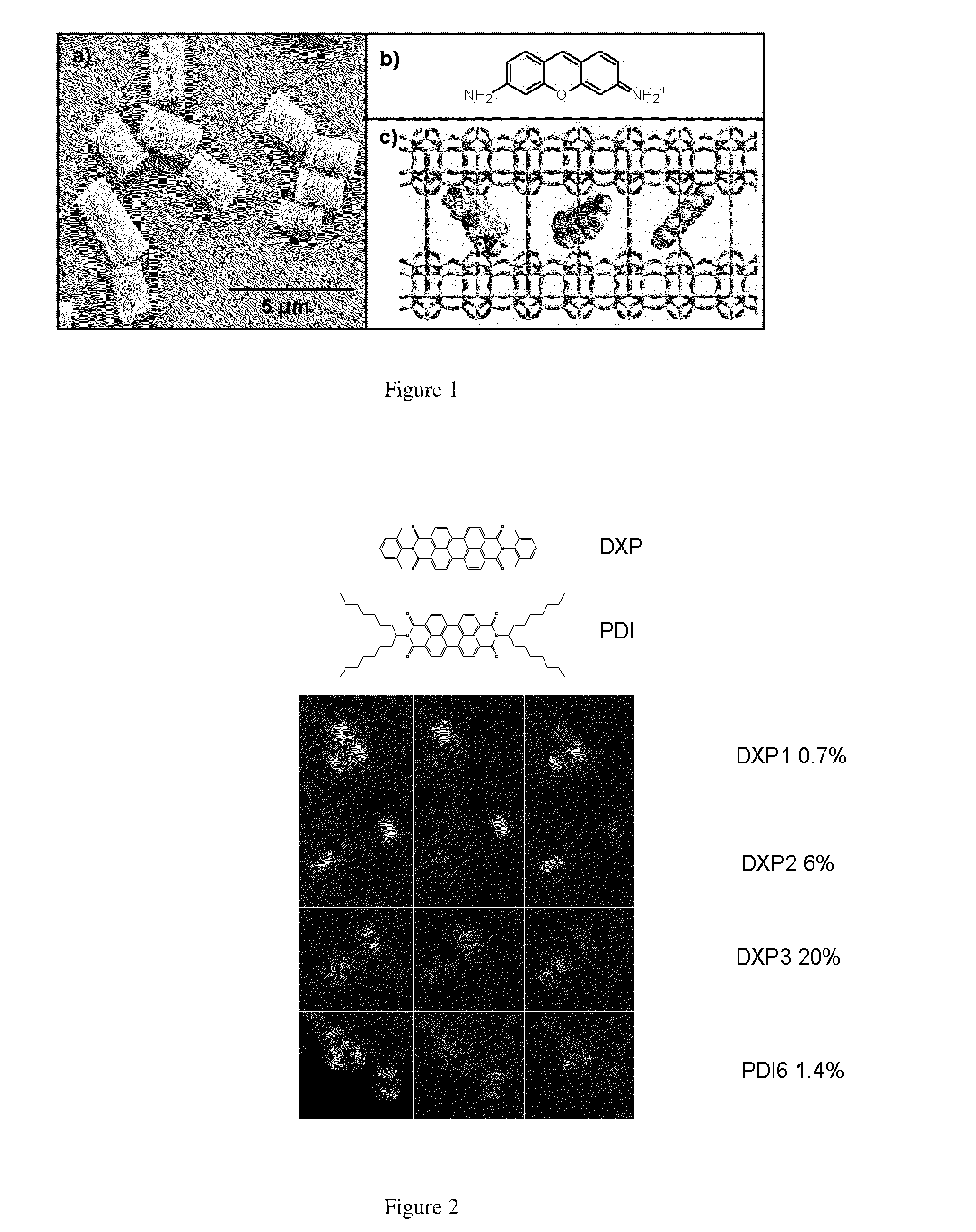Method for intercalating chromophores into zeolite-l nanochannels and products thereof
a technology of zeolitel nanochannels and chromophores, which is applied in the field of intercalation of chromophores into zeolitel nanochannels and products thereof, can solve the problems of limited experimental evidence, inability to achieve full potential, and difficulty in controlling coherence length, so as to confirm the chemical stability of chromophores
- Summary
- Abstract
- Description
- Claims
- Application Information
AI Technical Summary
Benefits of technology
Problems solved by technology
Method used
Image
Examples
example 1
[0073]The zeolite L crystals were synthesised by known methods. Potassium hydroxide (Fluka, pellets≧86%), sodium hydroxide (Merck, pellets≧99%) and aluminum hydroxide (Riedel-de Haën, powder purum) were diluted in bi-distilled deionised water. To this solution a silica suspension (Evonik AeroDisp W 1226) was added with vigorous stirring in order to obtain a white gel with the following composition 3 Na2O:9.6 Si2O:1 Al2O3:158.6H2O. The white gel was transferred into a Teflon vessel that was sealed and put into an oven for 144 hours at 160° C. The obtained white solid was washed several times with bi-distilled deionised water and dried. The zeolite L crystal was characterized with XRD, SEM and EDX.
example 2
Zeolite L Crystal Intercalation with Pyronine Chromophore
[0074]The zeolites L crystals were heated to 80° C. in the presence of an aqueous solution of pyronine for a period of 12 hours. Pyronine chromophore has been chosen due to its high absorption cross-section and emission quantum yield. Samples were dispersed and centrifuged repeatedly from methanol, in order to remove free dye absorbed on the zeolite L crystal surface. In the case of the sample corresponding to 20% loading, a second identical intercalation was performed. Loading assays were performed by dissolving a known mass of crystals in Hydrofluoric acid (HF) and measuring the absorption spectrum of the free chromophore, thus calculating its concentration, % loading=no. molecules / no. sites, where no. sites=no. unit cells×2.
example 3
Zeolite L Crystal Intercalation with Dxp Chromophore, Zeolite L Crystal Intercalation with PDI Chromophore
[0075]The 3 μm zeolite L crystals and the calculated amount of acetone chromophore solution were mixed in a glass ampoule and dried on a lab pump with the use of a heat gun. The ampoules were then sealed at a pressure of 10−5 mbar. Ampoules were placed in a rotating oven for 48 hours at 300° C. for DXP and 180° C. for PDI, temperatures were determined by the melting points of the chromophore molecules.
[0076]Higher or lower temperatures would either result in chromophore decomposition or a lack of filling the channels of the zeolite L crystals.
[0077]The intercalated zeolite L crystals were sonicated in and centrifuged from acetone several times until the supernatant was clear. Samples were also inspected under the microscope to ensure no free chromophore molecule were present.
[0078]Loading assays were performed by dissolving the DXP and PDI intercalated zeolite L crystals in 2 dr...
PUM
| Property | Measurement | Unit |
|---|---|---|
| channel length | aaaaa | aaaaa |
| coherence length | aaaaa | aaaaa |
| length | aaaaa | aaaaa |
Abstract
Description
Claims
Application Information
 Login to View More
Login to View More - R&D
- Intellectual Property
- Life Sciences
- Materials
- Tech Scout
- Unparalleled Data Quality
- Higher Quality Content
- 60% Fewer Hallucinations
Browse by: Latest US Patents, China's latest patents, Technical Efficacy Thesaurus, Application Domain, Technology Topic, Popular Technical Reports.
© 2025 PatSnap. All rights reserved.Legal|Privacy policy|Modern Slavery Act Transparency Statement|Sitemap|About US| Contact US: help@patsnap.com



